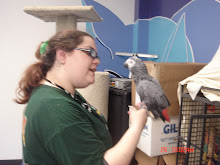
Both are 4 years old and both came to me in less than ideal circumstances.
First was Inyoni (a Zulu word meaning "bird") who was left out in the cold with nowhere to call home after her mate died and she became "too loud".
I took her in and moved her on up to a big cage with lots of toys and good foods.
She was not tame, and I pretty much let her carry on in that way as she was a happy, spunky lovebird who did not need human interaction to enjoy life.
Unfortunately 6 months after she came into my home she got into a fight with a toy and the toy won. Her leg was too damaged to save and it was amputated at the body so as not to leave a stump to get damaged. Inyoni hasn't let this hold her back and still loves to run around the house bossing the big birds around.

A year after Inyoni came along I was asked to take another lovebird. As his other option was to be released to fend for himself in winter, I of course took him in on a temporary basis, with the plan on finding him a forever home. He is a slate mutation Peachfaced Lovebird and goes by Ndeke (a Bembe word for "bird". Sensing a theme here?). Unfortunately, although I had planned on finding a forever home, Inyoni had decided that she was ready for a partner and put scupper to my plans. Half way through Ndeke's quarantine Inyoni got into his room and they took off. After 5 hours of trying to catch and separate them, I gave up and they have lived together ever since.

Inyoni and Ndeke have a very typical husband and wife relationship. Inyoni hangs out on her platform perch and nags Ndeke about how he's playing with the wrong toy, or getting her the wrong food, or he's not sticking the shredded paper into his rump feathers the right way.
Eggs are almost an inevitability when it comes to lovebirds. Inyoni laid one clutch before Ndeke came along, but since then I have managed to get it down to one single egg, every now and then. This has been achieved by carefully adjusting their diet so they get all their nutritional needs, but without them getting that abundance of food trigger for breeding. I am also careful about not putting toys in their cage which could be shredded to make a nest. However, they are birds and love to shred, so I do occasionally give them shreddable toys, but I remove the broken up pieces daily. So far this is working well for me and I have no lovebird chicks.
I have not done positive reinforcement training with the lovebirds yet. However I would like to teach them to target so I can transfer them into a travel cage for their yearly veterinary exams more easily.


No comments:
Post a Comment